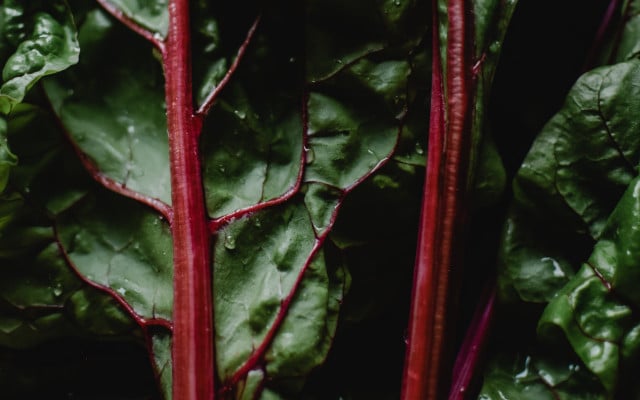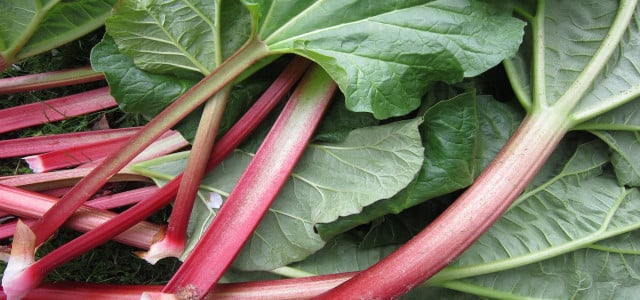You might not know that there are ways to use rhubarb leaves, even though you shouldn’t eat them (they are somewhat poisonous). We’ll show you how to put rhubarb leaves to good use so you don’t have to toss them.
Rhubarb is a tart and versatile spring vegetable … not fruit! You can use it to make things like jams, sauces, and pies. However, you should remove the leaves before using the stalks, because rhubarb leaves are poisonous to humans. The reason for this is the high amount of oxalic acid contained in these parts of the plant, which can be harmful to the kidneys in high concentrations. Learn when and how to harvest rhubarb to get the most out of it.
3 Rhubarb Leaves’ Uses for Your Plants

Rhubarb leaves are poisonous to humans, but a strong rhubarb leaf brew is great for your plants. Perfectly suitable for an organic garden, a concentrated rhubarb liquid can be used as a natural fertilizer or a safe pesticide spray. Here are the ways in which it can be useful:
- Strengthen your plants: Use the brew to help your plants grow and make them more resilient. Your plants will enjoy a growth aid in the spring, and a strength booster again before winter.
- Prevent potassium deficiency: Leaves of the rhubarb plant contain a lot of potassium, which plants need. Potassium deficiencies make plants more susceptible to diseases.
- Use as a remedy in case of diseases: Rhubarb leaves can help if your plants are already sick. In case of blight, remove the affected parts of the plant and spray the unaffected parts with a high-concentrate brew. This remedy may also help to get rid of aphids.
Here’s how to make a concentrated brew out of rhubarb leaves to use on your plants:
You’ll need:
- a pot
- a strainer
- a tea towel
- optional, for application: watering can / spray bottle
For use against disease infestation: use 1 part water to 1 part leaves.
To use as a fertilizer: use 5 parts water to 1 part leaves.
- Use a sharp knife to chop the leaves into small pieces.
- Add the chopped rhubarb leaves and water to the pot and bring to a boil.
- After about one minute, turn off the heat and let the rhubarb leaves steep for 30 minutes.
- Filter the liquid through a sieve. Squeeze the leaves with your hands or with the help of a tea towel.
- Toss the rhubarb leaves in the compost pile.
Another method is to put the leaves in a sealable container with warm or hot water. Place the lid on and let the brew infuse for 24 hours.
Note: This brew will keep in the refrigerator for a few days. It is best to use it up quickly to avoid fermentation. You can also freeze it, but be sure to label it as poisonous before putting it in your freezer.
Application:
- As a fertilizer or disease prevention: Water your plants with your rhubarb leaf brew during their growing season. Keep in mind that harvest time for rhubarb is spring/early summer.
- To fight plant diseases: Spray the affected plant with the rhubarb leaf brew once a day for about three days in a row.
Tip: Don’t use the brew on any plants that are food bearing.
4. Use Rhubarb Leaves For Composting
While rhubarb leaves aren’t safe for human consumption, there’s no reason not to add them to your compost pile! The oxalic acid has seemingly no effect on soil microorganisms and is not absorbed by plant roots. This means that plants grown in rhubarb-leaf compost are also safe to eat.
5. Boil Rhubarb Leaves to Make a Natural Dye
Simply boil the leaves for half an hour to get a warm yellow dye for natural fibres. Because of the oxylic acid contained in the rhubarb leaves, make sure that these garments don’t come into contact with food items. Don’t use this to dye a dish towel, for example. Instead, try finding some non-toxic natural dyes for fabric in our guide.
Important: Never use rhubarb leaves to make food dye. If you want to find out how to make different color food dyes, check out our guide Natural Red Food Coloring: How to Make Natural Food Dyes.
This article has been translated from German to English by Karen Stankiewicz. You can find the original here: Nicht wegwerfen! So kannst du Rhabarberblätter verwenden
** Links to retailers marked with ** or underlined orange are partially partner links: If you buy here, you actively support Utopia.org, because we will receive a small part of the sales proceeds. More info.Do you like this post?








